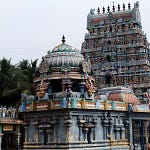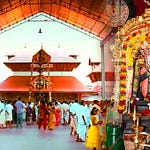The Ramanathaswamy Temple at Rameshwaram, located on the Pamban Island in Tamil Nadu, India, is a revered Hindu pilgrimage site and one of the twelve Jyotirlinga temples dedicated to Lord Shiva. This majestic temple stands as a symbol of devotion, rich culture, and timeless history. It is not only a prominent spiritual destination for Hindus but also a marvel of ancient architecture, renowned for its intricate designs, grand corridors, and unique rituals. The temple is especially significant due to its association with the epic Ramayana, a holy pilgrimage, and its symbolism in the tradition of purification and spiritual transformation.
Historical and Religious Significance
Rameshwaram is a place steeped in the legendary events of Hindu mythology, primarily linked to the Ramayana. According to legend, Lord Rama, the seventh incarnation of Lord Vishnu, sought the blessings of Lord Shiva before embarking on the battle against the demon king Ravana. Lord Rama, to absolve himself of the sin of killing Ravana, who was a Brahmin, decided to perform a ritual worship of Lord Shiva. Thus, the Ramanathaswamy Temple, also known as the temple of Ramanatha, was established at the site where Lord Rama performed his devotion.
The temple's historical significance is also rooted in its association with the sacred pilgrimage, Rameshwaram, which is believed to cleanse the sins of devotees. The temple’s mythological connection with the story of Lord Rama, and its position as one of the twelve Jyotirlingas, elevates its status as one of the holiest places in Hinduism.
Architectural Marvel
One of the most striking features of the Ramanathaswamy Temple is its architectural grandeur. Built in the Dravidian style, the temple is famous for its enormous corridors lined with ornate pillars that form the longest corridor in any Hindu temple. These corridors stretch a remarkable 1,220 meters, adorned with thousands of sculpted pillars, and are an extraordinary sight to behold. The temple complex includes various shrines dedicated to several gods and goddesses, with the central shrine being the most sacred.
The main sanctum houses the Shiva Linga, which is said to have been consecrated by Lord Rama himself. The temple complex is divided into multiple levels, with a tower (Shikhara) rising above the sanctum. The temple's inner sanctum (Garbhagriha) is designed in a way that ensures that devotees can offer their prayers with a sense of divine presence. The overall structure is marked by intricate carvings, including those of various deities, mythological figures, and motifs that depict Hindu philosophy.
Rituals and Religious Practices
Rameshwaram holds immense religious significance, and the temple is the center of several rituals and ceremonies. Devotees from all over the world come to seek Lord Shiva’s blessings, and the rituals followed at the temple are a blend of ancient customs and practices passed down through generations.
The Ritual of the 21 Water Tanks: The temple complex is home to 21 sacred water tanks or "Theerthams," each believed to have unique properties and powers. These tanks are an essential part of the temple’s purification rituals. Devotees are encouraged to bathe in these tanks, as the water is believed to purify them and absolve their sins. One of the most important practices is to immerse a mug of water from each of the 21 tanks and pour it over oneself before entering the temple, symbolizing spiritual cleansing. The tanks are a reminder of the temple’s association with purification and the holy river Ganga. The act of taking a dip in the sacred waters is said to wash away all sins, preparing the devotee for the darshan (spiritual sight) of Lord Shiva.
Puja and Offerings: The daily worship (puja) at the Ramanathaswamy Temple is an elaborate affair, conducted by the priests. The primary rituals include the Abhishekam (ritual bathing of the Shiva Linga), Archana (chanting of mantras in praise of the deity), and Arati (offering light to the deity). The temple also observes special poojas during significant festivals, particularly Mahashivaratri, Navaratri, and Ramanavami, marking the birthday of Lord Rama.
Prayers for Liberation (Moksha): The Ramanathaswamy Temple is not only a place for offering prayers for wealth, health, and success, but it is also believed to be a powerful site for moksha (liberation). Devotees visit the temple with the belief that their sins will be washed away and their path to liberation will be facilitated by the grace of Lord Shiva.
The Ritual of “Agni Theertham”: The temple is also connected with a sacred ritual known as Agni Theertham, in which devotees are required to take a holy dip in the sea at the eastern end of the temple, near the Ramanathaswamy Temple Beach. This ritual is a direct reference to Lord Rama’s seeking absolution for his actions, cleansing oneself from spiritual impurities and sins before entering the temple for prayers.
Unique Features and Spiritual Essence
The Ramanathaswamy Temple is an embodiment of the deep spiritual essence of the Shiva cult, and it holds a special place in the hearts of millions of devotees. Here are a few additional features that make the temple spiritually significant:
Sacred Significance: As a Jyotirlinga temple, it is one of the twelve most important Shiva temples in India. The Shiva Linga here is believed to be one of the 12 original forms of Lord Shiva.
Connection with Lord Rama: The temple is linked to Lord Rama’s mission to rescue his wife, Sita, from Ravana. This adds an additional layer of devotion for those who consider themselves followers of the Ramayana tradition.
Pamban Bridge: The journey to the Ramanathaswamy Temple is made even more remarkable with a scenic ride over the Pamban Bridge, which connects Rameshwaram to the mainland of Tamil Nadu. It offers breathtaking views of the Bay of Bengal and the Indian Ocean.
Presence of Several Shrines: Within the temple complex, there are several other smaller shrines dedicated to other deities like Lord Ganesha, Goddess Parvati, and Lord Vishnu.
The Ramanathaswamy Temple at Rameshwaram is not just a place of worship; it is an institution in itself, steeped in history, culture, and spirituality. For centuries, it has been a beacon of faith for millions, offering them a sanctuary for physical and spiritual purification. The unique architecture, the sacred water tanks, and the powerful rituals ensure that every devotee’s experience is deeply transformative. Whether you are a believer in the legends of Lord Rama or someone seeking peace and liberation, Rameshwaram offers an experience that transcends the ordinary.
For those looking to deepen their connection with Lord Shiva and the divine, Rameshwaram provides an unparalleled sacred space, one where faith, devotion, and tradition come together to form an unforgettable pilgrimage experience.










